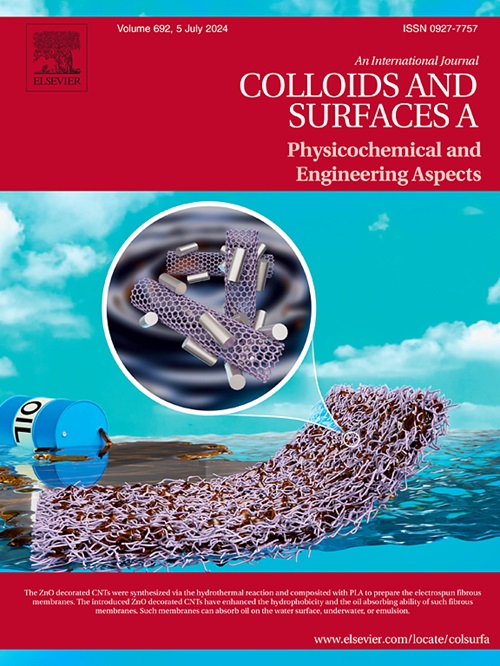活性染料在真丝织物上的深染性能及机理分析
IF 4.9
2区 化学
Q2 CHEMISTRY, PHYSICAL
Colloids and Surfaces A: Physicochemical and Engineering Aspects
Pub Date : 2025-06-24
DOI:10.1016/j.colsurfa.2025.137577
引用次数: 0
摘要
雄蚕产丝量高,丝质优良,是生产优质生丝的普遍选择。此外,也有报道称,男真丝织物具有优良的染色深度性能。本研究采用活性染料对真丝雌雄织物进行染色,全面探讨染色性能差异的潜在机制。结果表明,染色的男真丝织物比女真丝织物具有更大的表观深度和光泽。其中,当使用活性蓝19染料时,男真丝织物的K/S值明显高于女真丝织物,其染色效果的差异大约相当于染料浓度为50 mg/mL。拉曼光谱和酚色反应分析表明,雄性蚕丝纤维中的酪氨酸含量较高,且主要分布在纤维的表层,这种结构特征增强了活性染料的结合。此外,液相色谱-质谱(LC-MS)的定量分析进一步证实了这一发现。此外,分子对接研究和分子动力学模拟表明酪氨酸残基与活性染料之间存在稳定的共价键。这种分布趋势显著提高了雄丝对活性染料的吸附能力,提高了其对染料的吸收率。本研究不仅证实了雄丝具有出色的染色深度性能,而且阐明了活性染色过程中雌丝和雄丝的机理差异。研究结果为今后推广应用蚕丝提供了理论支持。本文章由计算机程序翻译,如有差异,请以英文原文为准。
Analysis of the deep dyeing property and mechanism of reactive dyes in male silk fabrics
The male silkworm has a high silk yield and superior silk quality, making it a popular choice for producing high-quality raw silk. Additionally, it has also been reported that male silk fabrics have excellent dyeing depth properties. In this study, reactive dyes were employed to dye both male and female silk fabrics, with a comprehensive exploration of the underlying mechanisms contributing to the differences in dyeing properties. The results demonstrated that dyed male silk fabrics exhibit greater apparent depth and luster compared to female silk fabrics. Specifically, when reactive blue 19 dye was utilized, the K/S values of male silk fabrics were significantly higher than those of female silk fabrics, with the difference in dyeing effect approximately equivalent to a dye concentration of 50 mg/mL. Raman spectroscopy and phenolic color reaction analysis revealed that the tyrosine content in male silk fibers was higher and predominantly located in the surface layer of the fibers, a structural feature that enhances the binding of reactive dyes. Additionally, quantitative analysis using liquid chromatography-mass spectrometry (LC-MS) further corroborated this finding. Furthermore, molecular docking studies and molecular dynamics simulations revealed stable covalent bonds between tyrosine residues and reactive dyes. This distribution trend significantly improves the adsorption capacity of male silk to reactive dyes and makes its dye uptake higher. This study not only confirms that male silk possesses outstanding dye depth performance but also elucidates the mechanistic differences between female and male silks during reactive dyeing processes. The findings provide theoretical support for promoting and applying male silk in the future.
求助全文
通过发布文献求助,成功后即可免费获取论文全文。
去求助
来源期刊
CiteScore
8.70
自引率
9.60%
发文量
2421
审稿时长
56 days
期刊介绍:
Colloids and Surfaces A: Physicochemical and Engineering Aspects is an international journal devoted to the science underlying applications of colloids and interfacial phenomena.
The journal aims at publishing high quality research papers featuring new materials or new insights into the role of colloid and interface science in (for example) food, energy, minerals processing, pharmaceuticals or the environment.

 求助内容:
求助内容: 应助结果提醒方式:
应助结果提醒方式:


